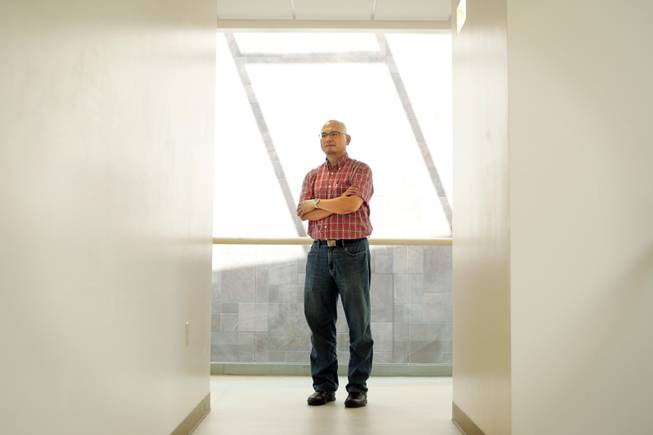
Yi-Tung Chen, co-director of UNLV’s Center for Energy Research, drew inspiration from his childhood in Taiwan to solve an energy problem.
Tuesday, Aug. 25, 2009 | 2 a.m.
Sun Coverage
Yi-Tung Chen’s problem was how to build a box with a hole that nothing can fall into or out of except for light.
Finding the solution would win him an award from the American Society of Mechanical Engineers and get his resulting paper accepted into the journal Renewable & Sustainable Energy Reviews.
Chen, the 49-year-old co-director of UNLV’s Center for Energy Research, was designing a tower that would produce hydrogen from water without using costly and inefficient electrolysis. Instead, the water would be vaporized and iodine and sulfur dioxide would strip the water into hydrogen and oxygen. But Chen is not a chemist. His concern was how to provide the monstrous heat needed, between 800 and 1,000 degrees Celsius.
Well, Chen thought, sunlight can be concentrated and reflected to produce such temperatures. No problem there, and a silicone carbide powder could absorb and retain that heat. Finding the proper diameter for the grains of the powder was a little tricky — too heavy and they would fall through the solar concentrating chamber too swiftly to heat, but if the grains were too small, they would fall too slowly or not at all, suspended in the air like dust motes in a sunbeam. Eventually Chen settled on 650-micron grains, tiny particles smaller than a tenth of a centimeter.
That left only the problem of the hole in the box.
To heat the sand falling through this box, Chen has to get sun into it, which means mirrors aimed at a hole in the side of the box. But a hole in the box also means problems with wind — it can blow cool air into the box and sand out. So glass, right? It’s good enough to cook the inside of your car, after all. Well, you can’t use regular glass, because it would be destroyed at those temperatures. There is glass that can withstand these temperatures, but it is very, very expensive and you would need a lot of it, because the hole we’re talking about is 3 by 5 meters — the size of four or five large men standing side by side.
Chen’s solution?
He remembered his childhood in Taiwan. Unlike the heat-blocking double doors of Nevada’s supermarkets, most Asian markets have only one set of doors. Instead of a second set of doors, these markets mount air jets above and inside their doors, and they blow down a curtain of air that prevents hot air from entering the stores.
Chen’s insight was that this air curtain could just as easily keep hot air in and cold air out. This solution appears to work very well in simulations.
Alas, it will have to wait in the real world.
The Energy Department has decided that hydrogen is not likely to be a workable alternative fuel within the next 20 or 30 years and has cut most of its research funding. Chen would prefer that the government think further ahead and plan for future generations, saying, “We must give the world an alternative. That is the spirit of the engineer and the scientist.”
But without money, what can he do? Nothing. Awards and publication aside, he may move into geothermal, solar, wind or nuclear research projects. It seems likely that despite a design model and hard-won expertise, Chen will be working on hydrogen only in his spare time, if he has any.
“We worked on it for years,” Chen says, laughing and throwing up his arms.

Join the Discussion:
Check this out for a full explanation of our conversion to the LiveFyre commenting system and instructions on how to sign up for an account.
Full comments policy